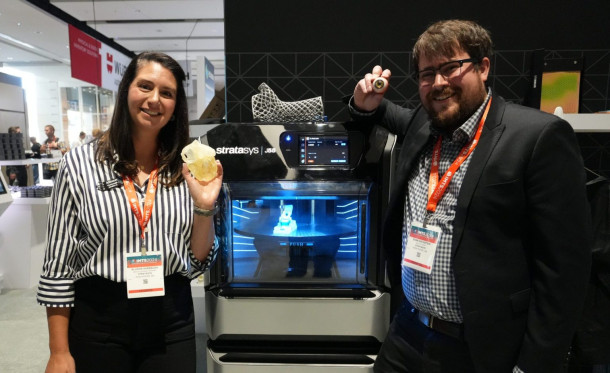At IMTS 2024, I learned about the latest technology for CNC lathes, robots, and most notably 3D printing.
Stratasys was the first 3D printing company I visited at the show. I spoke with Foster Ferguson, Director of Aerospace, and Tom Leach, Commercial Leader at Stratasys, about 3D printing applications for automotive and space vehicles. Then I spoke with Even Hochstein and Allison Harbaugh, Business Managers for the Stratasys Medical Team, about the capabilities of Stratasys 3D printers to replicate the feel and shape of body parts, which surgeons analyze before they operate on real human flesh.
More description coming later today!
*************
Listen on your favorite podcast app using pod.link.
View the podcast at the bottom of this post or on our YouTube Channel.
Follow us on Social and never miss an update!
Facebook: https://www.facebook.com/swarfcast
Instagram: https://www.instagram.com/swarfcast/
LinkedIn: https://www.linkedin.com/company/todays-machining-world
Twitter: https://twitter.com/tmwswarfblog
*************
Link to Graff-Pinkert’s Acquisitions and Sales promotion!
*************
Main Points
Part 1: 3D Printing in Aerospace, Defense, and Automotive Industries
The first half of the podcast, I with Foster Ferguson Director of Aerospace, and Tom Leach, Commercial Leader, at Stratasys. We focused on 3D printing technologies and applications in aerospace, defense, and automotive industries.
They showed me the H350 printer, which uses Selective Absorption Fusion (SAF) technology for large-volume production. A Ford F-150 Roush Performance Raptor mounting bracket demonstrates the printer’s ability to compete with injection molding for complex parts.
They emphasized 3D printing’s advantages: reduced tooling costs, increased design freedom, and quick iterations without expensive modifications. Ferguson mentioned a 95% 3D-printed drone, suggesting potential for on-site production in deployed situations.
Recent advancements include the introduction of polypropylene as a printing material, developed with BASF (now A.M. Forward), expanding their potential customer base.
Notable applications we discussed include:
1. A PolyJet-printed heart model that allows a surgeon to practice a complex procedure, saving a young girl’s life. (More detail in Part II of the interview)
2. A space-worthy panel made from PECK-based material with carbon nanotubes, developed with Lockheed Martin. About 300 such parts are currently in the Orion spacecraft.
They emphasized:
1. 3D printing’s competitiveness with traditional manufacturing for high-volume production.
2. Cost savings and design flexibility compared to injection molding.
3. Applications across automotive, aerospace, defense, and medical industries.
4. Rapid advancement in materials and processes.
5. Potential for on-site, on-demand manufacturing in various scenarios.
Part II: 3D Printing Applications for the Medical Industry
My second interview with features Evan Hochstein and Allison Harbaugh, Business Managers for the Stratasys Medical Team. We discussed 3D printing applications in the medical industry.
We talked about Stratasys’ capabilities in creating anatomically accurate models using various plastics that mimic tissue and bone. These models, derived from CT or MRI scans, allow surgeons to practice procedures and test new products, potentially reducing risks during actual surgeries.
The interviewees clarified that while they don’t create living organs, they’re working on biocompatible materials for applications like cutting guides and braces. They mentioned a collaboration with ColdPlant to develop 3D-printed breast implants for reconstruction after cancer.
Stratasys’ technology includes the Digital Anatomy Printer and the J5 MediJet, which can create detailed, multi-material, and multi-color models. They emphasized the importance of software in their workflow, mentioning partnerships with companies like Axial 3D and Materialize for FDA-cleared processes.
A notable example of their work includes creating a realistic heart model for a two-year-old patient with a congenital heart defect, which helped surgeons plan the procedure and explain it to the parents.
The interviewees also discussed the potential future of 3D printing in medicine, noting that while full organ printing isn’t currently possible, they’re focusing on patient safety and regulatory compliance in their developments.
Lastly, they mentioned their latest product, the Origin Two, a DLP (Direct Light Processing) printer that can create injection mold-like finishes, expanding their capabilities beyond their traditional PolyJet technology.
This summary was aided by claud.ai.
Question: If you attended IMTS 2024, which were your favorite exhibitors?
This article was originally posted on https://todaysmachiningworld.com/3d-printing-a-human-heart-at-imts-ep-226/
